NCERT Exemplar Class 7 Science Chapter 13 Motion and Time are part of NCERT Exemplar Class 7 Science. Here we have given NCERT Exemplar Class 7 Science Solutions Chapter 13 Motion and Time.
NCERT Exemplar Class 7 Science Solutions Chapter 13 Motion and Time
Multilple Choice Questions
Question 1.
Which of the following cannot be used for measurement of time?
(a) A leaking tap.
(b) Simple pendulum.
(c) Shadow of an object during the day.
(d) Blinking of eyes.
Solution:
(d) Eyes do not blink at fixed interval of time.
Question 2.
Two clocks A and Bare shown in figure. Clock A has an hour and a minute hand, whereas clock B has an hour hand, minute hand as well as a ‘ second hand. Which of the following statement is correct for these clocks?
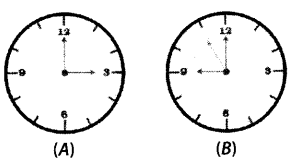
(a) A time interval of 30 seconds can be measured by clock A.
(b) A time interval of 30 seconds cannot be measured by clock B.
(c) Time interval of 5 minutes can be measured by both A and B.
(d) Time interval of 4 minutes 10 seconds can be measured by clock A.
Solution:
(c) Clock A can not measure seconds as it has not a second hand. Clocks A and B both have minute hands, so time interval of 5 minutes can be measured by both of them.
Question 3.
Two students were asked to plot a distance¬time graph for the motion described by table A and table B.
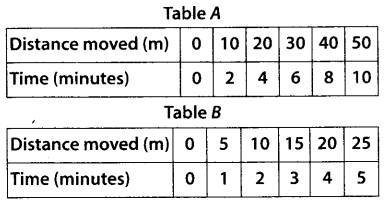
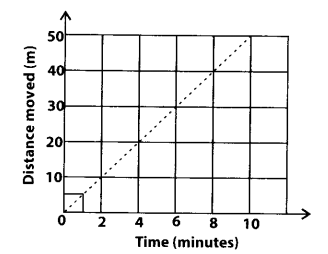
The graph given in figure is true for
(a) both A and B.
(b) A only.
(c) Sonly.
(d) neither A nor B.
Solution:
(a) Distance time graph for uniform motion shows a straight line. Slope is same for both table A and table B.
Question 4.
A bus travels 54 km in 90 minutes. The speed of the bus is
(a) 0.6 m/s
(b) 10 m/s
(c) 5.4 m/s
(d) 3.6 m/s
Solution:
![]()
Question 5.
If we denote speed by 5, distance by D and time by T, the relationship between these quantities is
(a) S=D × T
(b) T=S/D
(c) S=1/T x D
(d) S=T/D
Solution:
(c)
Question 6.
Observe figure.
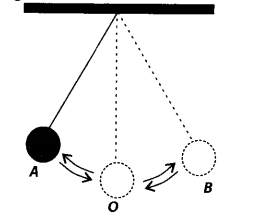
The time period of a simple pendulum is the time taken by it to travel from
(a) A to B and back to A.
(b) OtoA, 4 to 6 and 8 to 4.
(c) B to A, A to B and B to O.
(d) A to B.
Solution:
(a)
Question 7.
Figure shows an oscillating pendulum.
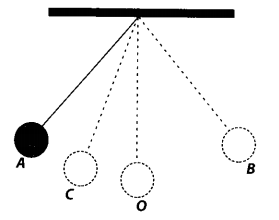
Time taken by the bob to move from A to C is f, and from C to O is f2. The time period of this simple pendulum is
(a) (t1 + t2)
(b) 2 (t1 + t2)
(c) 3 (t1 + t2)
(d) 4 (t1 + t2)
Solution:
(d) Time taken by the bob to move from

Question 8.
The correct symbol to represent the speed of an object is
(a) 5 m/s
(b) 5 mp
(c) 5 m/s-1
(d) 5 s/m
Solution:
(a)
Question 9.
Boojho walks to his school which is at a distance of 3 km from his home in 30 minutes. On reaching he finds that the school is closed and comes back by a bicycle with his friend and reaches home in 20 minutes. His average speed in km/h is
(a) 8.3
(b) 7.2
(c) 5
(d) 3.6
Solution:
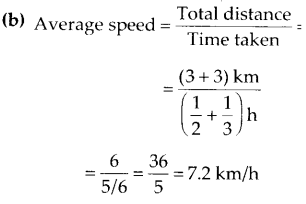
Very Short Answer Type Questions
Question 10.
A simple pendulum is oscillating between two points A and B as shown in figure. Is the motion of the bob uniform or non-uniform?
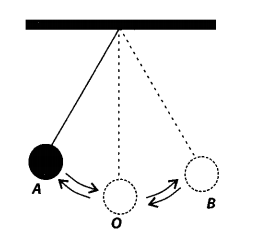
Solution:
Motion of the bob is non-uniform as its speed keeps changing.
Question 11.
Paheli and Boojho have to cover different distances to reach their school but they take the same time to reach the school. What can you say about their speed?
Solution:
Paheli and Boojho have different speeds.
Question12.
If Boojho covers a certain distance in one hour and Paheli covers the same distance in two hours, who travels in a higher speed?
Solution:
Boojho moves at a higher speed as he covers the same distance in a lesser time than Paheli.
Question 13.
Complete the data of the table given below with the help of the distance-time graph given in figure.

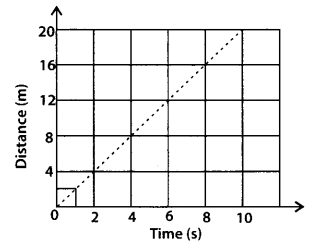
Solution:

Question 14.
The average age of children of Class VII is 12 years and 3 months. Express this age in seconds.
Solution:
12 years 3 months
= 12 x 365 + 3 x 30 = 4470 days
= 4470 x 24 x 60 x 60 s = 386208000 s
Question 15.
A spaceship travels 36,000 km in one hour. Express its speed in km/s.
Solution:
Speed of spaceship = 36,000 km/h
Question 16.
Starting from A, Paheli moves along a rectangular path ABCD as shown in figure 7. She takes 2 minutes to travel each side. Plot a distance-time graph and explain whether the motion is uniform or non-uniform.
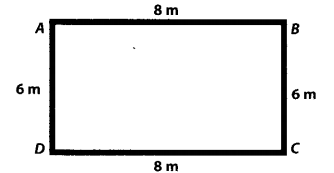
Solution:
Since the distance covered per unit time for the entire rectangular path covered is not the same, the motion is non-uniform.
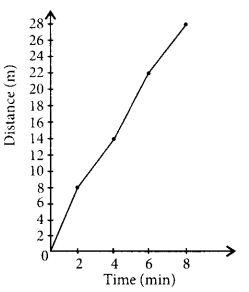
Question 17.
Plot a distance-time graph of the tip of the second hand of a clock by selecting 4 points on x-axis and y-axis respectively. The circumference of the circle traced by the second hand is 64 cm.
Solution:

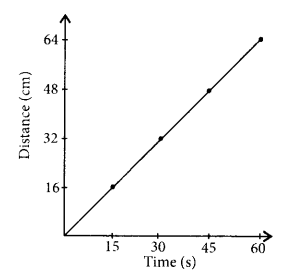
Long Answer Type Questions
Question 18.
Figure given below is the distance-time graph of the motion of an object.
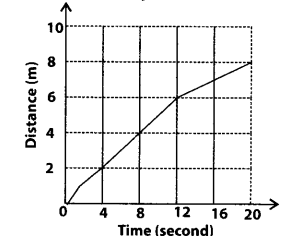
(i) What will be the position of the object at 20 s?
(ii) What will be the distance travelled by the object in 12 s?
(iii) What is the average speed of the object?
Solution:
(i) At 20 s, the object will be 8 m away from the starting point.
(ii) In 12 s, distance travelled by the object will be 6 m.
(iii) Average speed of the object Total distance=Total distance/Time taken=8m/20s=0.4m/s
Question 19.
Figure given below is the distance-time graph of the motion of an object.
Distance between Bholu’s and Golu’s house is 9 km. Bholu has to attend Golu’s birthday party at 7 o’clock. He started from his home at 6 o’clock on his bicycle and covered a distance of 6 km in 40 minutes. At that point he met Chintu and he spoke to him for 5 minutes and reached Golu’s birthday party at 7 o’clock. With what speed did he cover the second part of the journey? Calculate his average speed for the entire journey.
Solution:
Distance between Bholu’s and Golu’s house = 9 km
Distance covered by Bholu in first part of the journey = 6 km
Time taken to cover 6 km = 40 min
Distance covered by Bholu in second part of the journey = 9-6 = 3 km
Time taken to cover 3 km = 60 – (40+5)=15 min
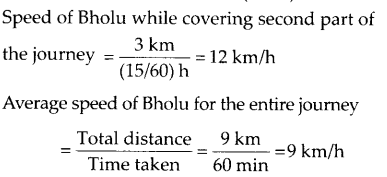
Question 20.
Boojho goes to the football ground to play football. The distance-time graph of his journey from his home to the ground is given as figure.
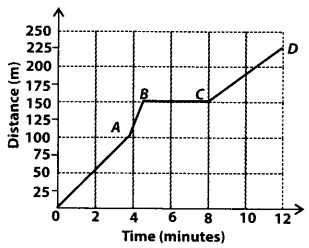
(a) What does the graph between point B and C indicate about the motion of Boojho?
(b) Is the motion between 0 to 4 minutes uniform or non-uniform?
(c) What is his speed between 8 and 12 minutes of his journey?
Solution:
(a) Graph between point B and C is a horizontal line which indicates that Boojho is at rest, i.e. his speed is zero.
(b) Motion between 0 to 4 minutes is non-uniform as distance-time graph for this time interval is not a straight line.
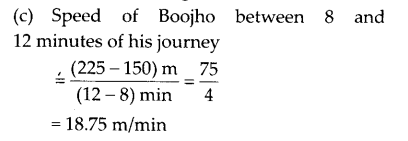
NCERT Exemplar Class 7 Science Solutions
- Chapter 1 Nutrition in Plants
- Chapter 2 Nutrition in Animals
- Chapter 3 Fibre to Fabric
- Chapter 4 Heat
- Chapter 5 Acids, Bases and Salts
- Chapter 6 Physical and Chemical Changes
- Chapter 7 Weather, Climate and Adaptations of Animals to Climate
- Chapter 8 Winds, Storms and Cyclones
- Chapter 9 Soil
- Chapter 10 Respiration in Organisms
- Chapter 11 Transportation in Animals and Plants
- Chapter 12 Reproduction in Plants
- Chapter 13 Motion and Time
- Chapter 14 Electric Current and Its Effects
- Chapter 15 Light
- Chapter 16 Water: A Precious Resource
- Chapter 17 Forests: Our Lifeline
- Chapter 18 Wastewater Story
We hope the NCERT Exemplar Class 7 Science Chapter 13 Motion and Time will help you. If you have any query regarding NCERT Exemplar Class 7 Science Solutions Chapter 13 Motion and Time, drop a comment below and we will get back to you at the earliest.